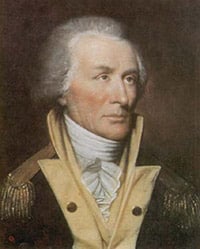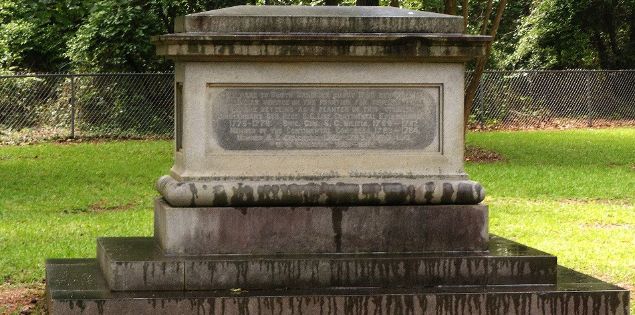Thomas Sumter was a soldier in the Colony of Virginia militia, a brigadier general in the South Carolina colonial militia during the American Revolutionary War, a planter, and a politician. After the United States gained independence, he was elected to the United States House of Representatives and to the United States Senate, where he served from 1801 to 1810, when he retired. Sumter was nicknamed the "Carolina Gamecock" for his fierce fighting style against British soldiers after they burned down his house during the Revolution.
Jump to:
Thomas Sumter Facts: Military Life

- Thomas Sumter was born in Hanover County, Virginia Colony. Little is known of Sumter's early life. He was given just a basic education on the frontier. The young Sumter enlisted in the Virginia militia.
- At the end of the Anglo-Cherokee War, in 1761, Sumter was invited to join what was to become known as the "Timberlake Expedition," organized by Colonel Adam Stephen and led by Henry Timberlake.
- The purpose of the expedition was to visit the Overhill Cherokee towns and renew friendship with the Cherokee People following the war. The small expeditionary party consisted of Timberlake, Sumter, an interpreter named John McCormack, and a servant.
- At one point early in the nearly year-and-a-half-long journey, an entry in Timberlake's journal describes Sumter's swimming nearly a half-mile in the icy waters to retrieve their canoe, which had drifted away while they were exploring a cave.
- The party arrived in the Overhill town of Tomotley on December 20, where they were greeted by the town's head man, Ostenaco, and soon found themselves participants in a peace pipe ceremony.
- Sumter and the group attended peace ceremonies in several Overhill towns, such as Chota, Citico, and Chilhowee.
- In February 1776, Sumter was elected lieutenant colonel of the Second Regiment of the South Carolina Line, of which he was later appointed colonel. He subsequently was appointed brigadier general, a post he held until the end of the war.
- He participated in several battles in the early months of the war, including the campaign to prevent an invasion of the Georgia Colony. Perhaps his greatest military achievement was his partisan campaigning, which contributed to Lord Cornwallis' decision to abandon the Carolinas for Virginia.
- Sumter acquired the nickname "Carolina Gamecock" during the American Revolutionary War for his fierce fighting tactics. After the Battle of Blackstock's Farm, British General Banastre Tarleton commented that Sumter "fought like a gamecock", and Cornwallis described the Gamecock as his "greatest plague.
- He resigned from the commission as Commander of The Regiment, Continental Line, 1778.
- After the fall of Charleston to Clinton in 1780, while the South Carolina Colony lay prostrate, Thomas Sumter formed the first militia to renew the struggle. For 18 months, he alone was the South Carolina government. Governor John Rutledge (brother of signer Edward Rutledge) had moved the capitol to North Carolina.
- He repulsed an attack on Tumbull's camp at Rocky Mount on July 30, 1780, and then defeated the British at Hanging Rock on August 6,1780, destroying the Prince of Wales Regiment.
- Sumter was met with defeat in a surprise night attack by Colonel Banastre Tarleton at Fishing Creek on August 18, 1780.
- Governor Rutledge gave him a commission as brigadier general in October of that year.
- He won the Battle at Fish Darn Ford on November 9, 1780, and captured Wemyss, a British Commander.
- He got some revenge on Tarleton when he defeated him at Blackstock's on November 20, 1780. The victory came at a cost. Sumter was wounded in the back and chest. Defeated Tarleton at Blackstock's November 20, 1780.
Thomas Sumter Facts: Civic Service
- He was elected a delegate from the district eastward of the Waterer to the First and Second Provincial Congresses, which met in Charles Town in 1775 and 1776. There, he was made a member of the Council of Safety and, immediately after the Skirmish at Lexington, was made a Captain of Rangers and then a Lieutenant Colonel Commandant of the rifle regiment. He was also present and took part in the adoption of the second American State Constitution by the terms of which the South Carolina colony became an independent sovereignty.
- He was a man of many varied interests, ranging from experiments with tobacco, cotton, and silkworms.
- He also raised fine racing horses, founded the town of Stateburg after the war, and held land grants for more than 150,000 acres of land.
- Service to his community, state, and country continued from 1782 to December 16, 1810, when he retired from public life.
- In 1778, he was elected by his people to the first General Assembly under the new Constitution, and after his "War Days," he was elected to the state Senate, which met in Johnsonborough, South Carolina, in 1782.
- Thomas Sumter was elected to the Assembly, which met in Charleston in 1785. He was re-elected and was a member of the Assembly when, in 1788, the Proposed Constitutional Convention was received.
- He was again a member of the Legislature, which met in 1789, this being his last session in the State General Assembly, thereafter refusing other nominations.
- He was elected to the First Congress, which me in New York in 1789.
- Sumter was elected to the Second Congress but suffered his only defeat in the election of 1793. He remained out of politics for three years, but in 1796, he again offered and was elected as a member of Congress held in the new Capitol in Washington, DC.
- Sumter was the only member from SC who voted for Thomas Jefferson instead of Aaron Burr when the election for President was thrown into Congress.
Thomas Sumter Facts: Last Years and Legacy
- December 1801, the General Assembly of South Carolina elected Congressman Sumter over John Rutledge to fill Charles Pinkney's unexpired term as a Senator when the Pinkney was sent to the Court of Spain.
- At the expiration of the term, he was elected Senator and re-elected in December 1810. But Sumter, then 76 years of age and beginning to be weary of public service and harassed by complications in his vast private enterprises, resigned and retired to end his days among the High Hills of Stateburg.
- In the last year of life, he took a stand on a principle of government closest to his heart - that principle then and now, referred to as "States Rights."
- It was then that John Calhoun's doctrine of the right of nullifications by a state, in the event its reserved powers had been transgressed upon by the Federal Government, was being insisted upon by South Carolina. That dispute was at its height when he died at the age of 98.
- General Thomas Sumter served his country under four presidents. He died June 1, 1832, at his home in Stateburg, South Carolina, and was the last surviving General of the American Revolutionary War.

Thomas Sumter Facts: Online Resources
- Wikipedia - Thomas Sumter Biography
- SumterSC.com - Comprehensive Biography of Thomas Sumter
- General Thomas Sumter Memorial Park
- Find A Grave - Thomas Sumter
- Find A Grave - Mary Canter Sumter
- Find A Grave - Thomas Sumter Jr.
- Thomas Sumter Homestead
- South Carolina Hall of Fame
- Sumter County Museum
